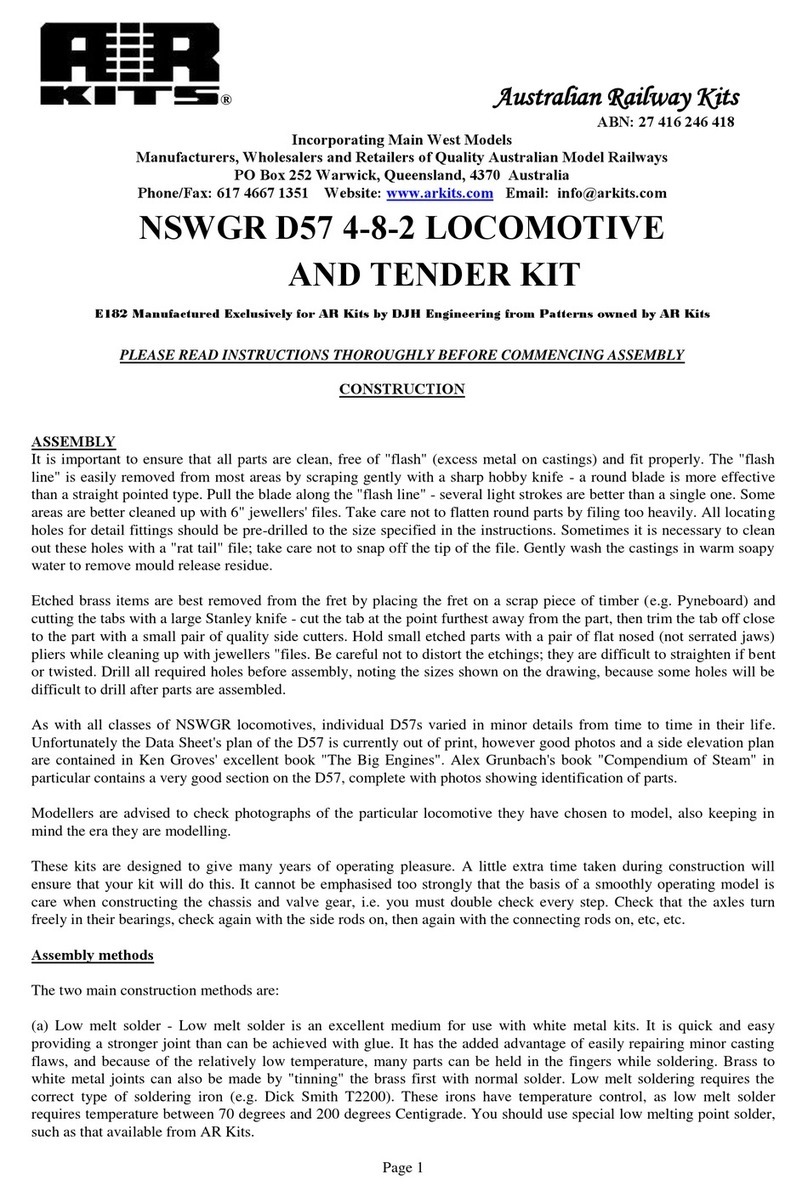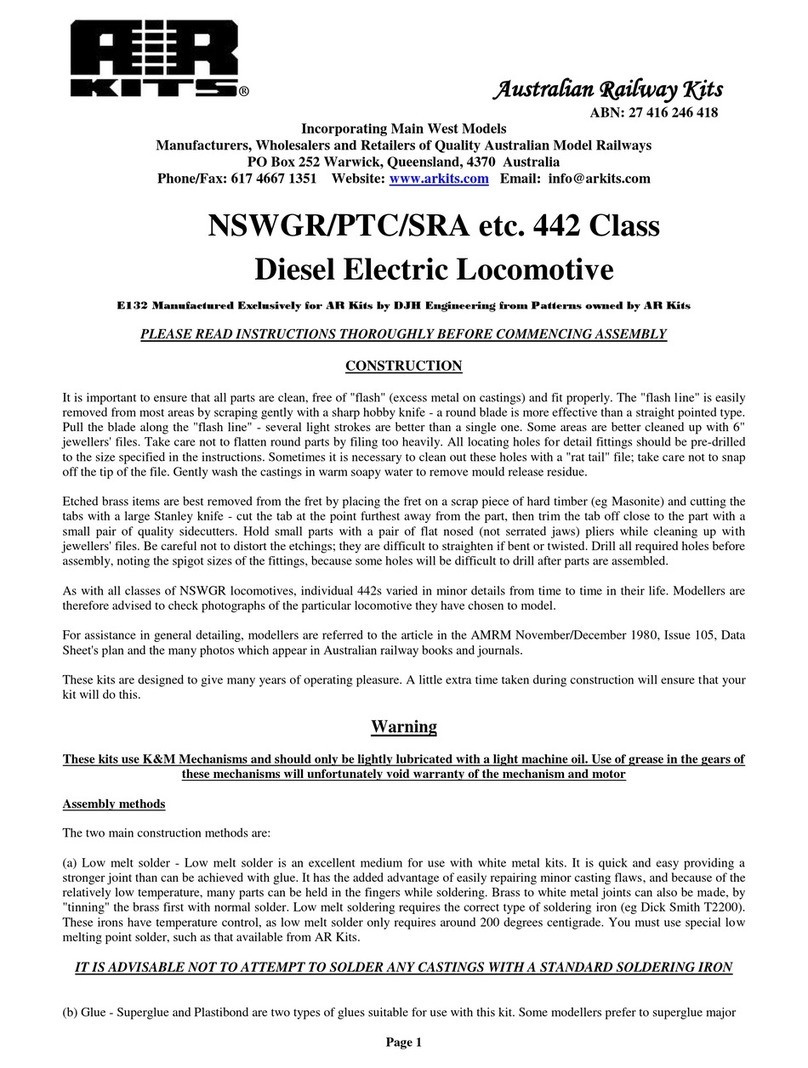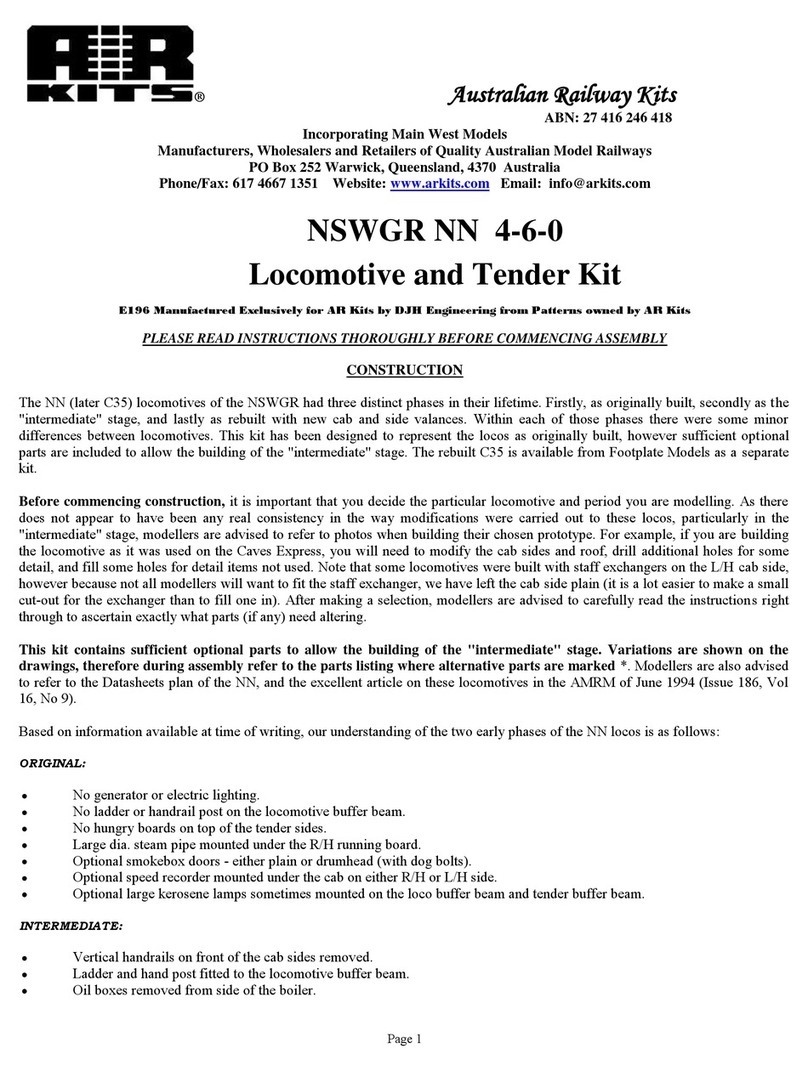
Push the brass wheel bearings (34x8) in the bogie sideframes using low melt solder if necessary, and attach the sideframes to the
stretcher with the brass spacer screws (36x4)and washers (37x4) (also from the nickel silver fret).
Tighten the screws then gently ease the sideframes apart to fit the wheelsets (39x4) in place, making sure the insulated wheels are
on the same side for each bogie - see drawing 1(LS =1ive side), these wheels can be identified by the small brass collar between the
wheel and axle.
Attach the assembled bogies to the tender using the spacer screws (41x2) and bogie bearing washers (40x2) making sure that the
insulated wheels are on the R/H side.
Working (soldering) from inside the tender, fit the junction box (23), marker lamps (24x2), grab handle (0.4mm wire), and lamp
irons (21x2). Fold the ladder (22) as shown and fit to the tender back. Fix the brake hose (27) to the buffer beam (7), followed by
the buffers (25x2). Using 1.0mm wire fit the overflow pipe to the side valances (8x2). Fit pipe connector (26) to the rear hole (R/H
side only). Trim both overflow pipes to a length of 3.Smm to clear the bogies.
Drill the tender top (12) 0.5mm on the front L/H side as shown for later fixing of the fireiron stand (19). Fit the toolbox (15), air
vent (16) and water filler (17) to the tender top (12). Note that you may have to cut out a small section at the rear of the tender top
(12) to clear the lamp irons (21). Now fit the tender top (12) to the tender body placing the rear section under the ladder uprights
before final positioning of the tender top.
Fit the hungry boards (13x2) to the tender top (12), noting that the L/H hungry board has additional rivets to match the fire iron
brackets (18x3). Fit the rear coal partition (14) to the tender top (12). Fold the coal shute (5) and fit to the tender front (3), then fold
the coal doors (6) and fit to the tender front. Fit the brake handle (29) into the brake stand (28) and fix the assembly into the tender
floor (4). Using 0.4mm wire fit the vertical handrails either side of the tender front.
Fit the fireiron standard (19) to the tender top (12) followed by the fireiron brackets (18x3) and fireirons (20x2). Fit the tender top
front plates (43) and the builders plates (43A).
Locomotive Drawing 1 (Parts 44 - 83)
As mentioned previously all holes shown on the drawings should be drilled prior to assembly. Clean up the footplate (44) and
remove any feed sprues from the centre cutout under the boiler. Fix the smokebox/boiler/firebox (50) to the footplate (44).
Fold the tabs on the cab spectacle plate (45) as shown before fixing the spectacle plate to the footplate. Note that you will need to
remove 0.5mm from the bottom of the side tabs to allow the bottom tabs to fold properly. If using the original cab sides (porthole
window) (46x2), fit the 0.4mm wire handrails to each side before fixing them to the footplate.
If using the rebuilt cab sides (square windows) (47x2), fit the detail strips (48x2) and the 0.4mm handrails in place before fixing the
cab sides to the footplate. If using the rebuilt cab sides, fit the two valance plates (81x2) to the footplate. You may find it easier to
fit the cab roof (49) after the interior cab detail has been fitted.
Using 0.4mm wire make up and add the short horizontal handrail (69) to the smokebox front (68), followed by the smokebox door
handle (70) before fitting smokebox front (68) to the smokebox/boiler (50). Commence detailing, fitting the headlight (56),
chimney (55), dome (54), safety valve (51), steam generator (52 - add 0.5mm wire) and whistle (53).
Fix the lamp bracket (66), R/H marker lamp (67), pump (63), clack valve (61), pipe connection (60) and globe valve (57). Fix
handrail knob (65), long handrail bracket (59), short handrail bracket (58).
This drawing also shows detailing of the front buffer beam using the brake hose (72), buffers (71x2), dummy coupling (76), front
step (73) and handrail post (75).
Fit the pump air filter (64) and 0.4mm piping. Fit the rear splasher (82x2) - remove the top plate for the original version before
adding the splasher pipe bracket (83x2). Fold the step (77x2) as shown, then add the step detail (78x2), followed by step treads
(79x2). Attach the completed step assembly in place, before the injectors (80xpair). Lastly, add the lamp brackets (74x4).
Locomotive Drawing 2 (Parts 84 - 105)
Continue detailing the L/H side of the locomotive fitting the L/H lamp bracket (103), marker lamp (104), junction box (93), clack
valve (86), handrail bracket (84) and handrail knob (85), double handrail bracket (87), short handrail bracket (88) and globe valve
(89). Lastly, fit pipe brackets (92x2), the reversing rod (91).
Take the lower cab floor (94) and fold the tabs and rear flap down 90 degrees as shown. Take the fallplate (95) and fold the tabs
down 90 degrees, then glue the plasticard (96) to the underside, trimming it so that it overlaps the three outside faces by 0.8mm to
prevent it shorting out against the tender. Position the fall plate (95) on the lower cab floor (94), then place the upper cab floor (97)
on top to retain it. Fix the upper cab floor in place be soldering along the edge of each side. Locate the finished floor assembly
inside the cab and fix in place. Fix the boiler backhead in place. Lastly, fold the guardirons (90) and fix to the underside of the
buffer beam.Fix the brake handle (100) into the brake stand (99) and fix the completed assembly in place. Add the cab seats
(101&102) to complete the cab detail. Note that the spacer screws (105x2) are used later to secure the body to the chassis.
Page 3






























